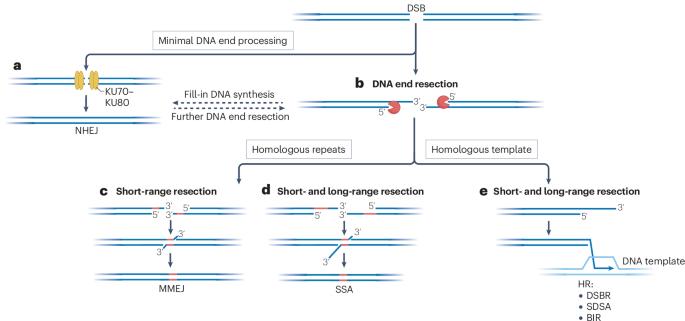Mechanisms and regulation of DNA end resection in the maintenance of genome stability
IF 90.2
1区 生物学
Q1 CELL BIOLOGY
引用次数: 0
Abstract
DNA end resection is a crucial early step in most DNA double-strand break (DSB) repair pathways. Resection involves the nucleolytic degradation of 5′ ends at DSB sites to generate 3′ single-stranded DNA overhangs. The first, short-range resection step is catalysed by the nuclease MRE11, acting as part of the MRE11–RAD50–NBS1 complex. Subsequent long-range resection is catalysed by the nucleases EXO1 and/or DNA2. Resected DNA is necessary for homology search and the priming of DNA synthesis in homologous recombination. DNA overhangs may also mediate DNA annealing in the microhomology-mediated end-joining and single-strand annealing pathways, and activate the DNA damage response. By contrast, DNA end resection inhibits DSB repair by non-homologous end-joining. In this Review, we discuss the importance of DNA end resection in various DSB repair pathways, the molecular mechanisms of end resection and its regulation, focusing on phosphorylation and other post-translational modifications that control resection throughout the cell cycle and in response to DNA damage. DNA end resection is crucial for most DNA double-strand break repair pathways. This Review discusses the molecular mechanisms of end resection and its regulation, focusing on the roles of post-translational modifications throughout the cell cycle and in response to DNA damage.


DNA末端切除在维持基因组稳定性中的机制和调控
DNA末端切除是大多数DNA双链断裂(DSB)修复途径中至关重要的早期步骤。切除涉及DSB位点的5 ‘末端的核分解降解,以产生3 ’单链DNA悬垂。第一步,短程切除步骤由核酸酶MRE11催化,作为MRE11 - rad50 - nbs1复合物的一部分。随后的远程切除由核酸酶EXO1和/或DNA2催化。在同源重组中,切除的DNA是同源性搜索和DNA合成启动所必需的。DNA悬垂也可能通过微同源介导的末端连接和单链退火途径介导DNA退火,并激活DNA损伤反应。相反,DNA末端切除通过非同源末端连接抑制DSB修复。在这篇综述中,我们讨论了DNA末端切除在各种DSB修复途径中的重要性,末端切除的分子机制及其调控,重点是磷酸化和其他翻译后修饰,这些修饰在整个细胞周期和DNA损伤响应中控制切除。
本文章由计算机程序翻译,如有差异,请以英文原文为准。
求助全文
约1分钟内获得全文
求助全文
来源期刊
CiteScore
173.60
自引率
0.50%
发文量
118
审稿时长
6-12 weeks
期刊介绍:
Nature Reviews Molecular Cell Biology is a prestigious journal that aims to be the primary source of reviews and commentaries for the scientific communities it serves. The journal strives to publish articles that are authoritative, accessible, and enriched with easily understandable figures, tables, and other display items. The goal is to provide an unparalleled service to authors, referees, and readers, and the journal works diligently to maximize the usefulness and impact of each article. Nature Reviews Molecular Cell Biology publishes a variety of article types, including Reviews, Perspectives, Comments, and Research Highlights, all of which are relevant to molecular and cell biologists. The journal's broad scope ensures that the articles it publishes reach the widest possible audience.

 求助内容:
求助内容: 应助结果提醒方式:
应助结果提醒方式:


